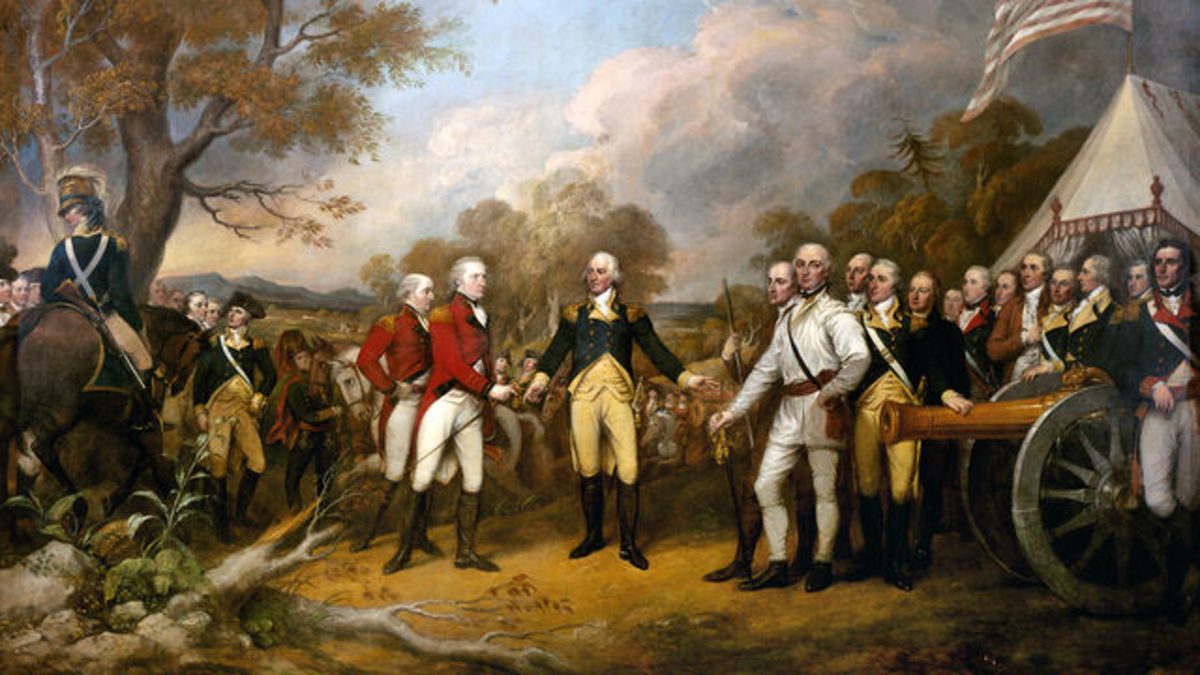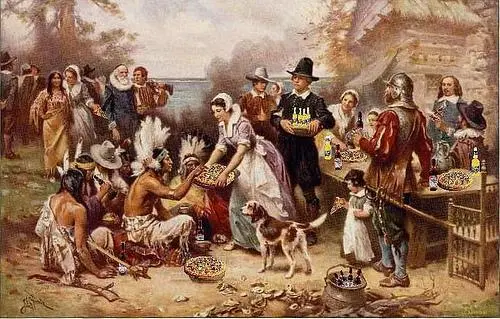Throughout the eighteenth century, in the years leading up to the American Revolution, many colonists pondered issues related to independence and governance. Support for religious freedom played a role in the civic life of the colonies, and in the 1730s and 1740s a revival of religious faith known as the Great Awakening took hold. Jonathan Edwards, a Congregationalist minister, played a vital role in this movement, which deemphasized tradition and ritual in religion, focusing instead on helping believers to develop a personal connection with their faith: to feel emotionally attached to their beliefs rather than to experience them intellectually. In 1741 he delivered the sermon “Sinners in the Hands of an Angry God,” which outlines the misery of hell awaiting those who ignore God’s teaching. His sermon ends by summoning sinners to return to God while time remains to repent: “it is that natural men are held in the hand of God, over the pit of hell; they have deserved the fiery pit, and are already sentenced to it … ‹In short, they have no refuge, nothing to take hold of; all that preserves them every moment is the mere arbitrary will, and uncovenanted, unobliged forbearance of an incensed God” (156–57). In addition to the sermons of Edwards, George Whitefield, with his “Marks of a True Conversion” and “The Great Duty of Family Religion,” and Gilbert Tennent, with “The Danger of an Unconverted Ministry,” also participated in the Great Awakening, which likely influenced the coming American Revolution. The emphasis on personal, emotional experience rather than solely on churches’ official positions, as well as the recognition that all people face the same possibilities of salvation or damnation, may have primed Americans for more revolutionary ideas in politics and governance.
Throughout the remainder of the eighteenth century, American literature developed a character based less on faith and more on intellect. Benjamin Franklin, one of the most famous figures in the American Revolution, published his Poor Richard’s Almanack from 1733 through 1758, distributing useful information on such subjects as the weather, eclipses, and tides. More notably, Franklin’s almanacs instruct their readers with maxims, many of which remain in currency today: “He that goes far to marry, will either deceive or be deceived” (6), “Humility makes great men twice honourable” (7), and “Early to bed and early to rise, makes a man healthy wealthy and wise” (9). Years later he co-authored the Declaration of Independence (1776). Franklin’s Autobiography chronicles his rise from modest beginnings as the son of a candle maker, his training as a printer, and his success as a newspaper editor, leading to his position as a representative of the colonies. Franklin died before The Autobiography was completed, and so only events occurring prior to 1758 are depicted. An excellent example of autobiography, Franklin presents himself with refreshing candor.
A number of tracts criticizing colonial rule and promoting the establishment of the United States of America was published throughout the latter half of the eighteenth century. In Common Sense, published anonymously a few months before the start of the American Revolution in 1776, Thomas Paine articulates a “common sense” argument against British rule over America and for the development of an American government. Paine followed this publication with sixteen pamphlets collectively entitled The Crisis, published from 1776 through 1783. The Crisis inspired American readers, criticizing the tyranny of the English who, he believed, usurped powers that only God should have over men. He firmly believed that Americans were right to fight for independence.
Other authors focused on issues uniquely American in nature. J. Hector St. John de Crèvecoeur wrote Letters from an American Farmer (published 1782) prior to the American Revolution, while living on his farm, Pine Hill, in New York. In these letters, he discusses the animals, plants, and communities of America. For the most part, he idealizes the nation, discussing the multinational origins of Americans, their religious diversity, and the country’s role as a refuge for the poor and disenfranchised. Crèvecoeur advances the idea of America as a melting pot: “Here individuals of all nations are melted into a new race of men, whose labours and posterity will one day cause great changes in the world” (70). Along with his positive representations of America, Crèvecoeur acknowledges the country’s weaknesses, condemning slavery and the failure of Americans to recognize the suffering of enslaved men and women. In his letters Crèvecoeur discerns a distinctly American culture in this fledgling nation.
Thomas Jefferson’s Notes on the State of Virginia (1785) discusses the colony’s natural resources and influential social elements in America. Jefferson provides data about Virginia’s land and resources and discusses its people, religions, and laws, among other subjects. In his discussion of
slavery, Jefferson theorizes that, due to long-held prejudices and the effect of slavery, blacks and whites could not live together effectively in Virginia society. He therefore advocates relocating black men and women to Africa, after a period of education and work as slaves. Although Notes on the State of Virginia is among the most respected works of the eighteenth century, Jefferson’s position on slavery continues to create debate and criticism among current readers, especially in light of his relationship with his slave Sally Hemmings.
True independence and the establishment of American citizenship did not extend to African Americans or American Indians. Even so, a number of these Americans played important roles in this period of American literary history. Among the many ministers publishing sermons, Samson Occom, a Mohegan and Presbyterian minister, penned his “Sermon Preached at the Execution of Moses Paul” in 1772, the first publication in English by an indigenous writer. This sermon was delivered in Connecticut at the execution of Moses Paul, a Mohegan who killed a white man. Occom, a skilled rhetorician, published his sermon soon after its delivery, and it went through nearly twenty editions into the nineteenth century. Olaudah Equiano, born in what is now Nigeria circa 1745, was captured as a slave in 1756, sent to Barbados, and eventually sold to a Pennsylvania merchant. After buying his freedom in 1766, he left for England, later traveling to many other countries, but never returning to America. Equiano strongly supported abolition and lectured on the subject in England. The Interesting Narrative of the Life of Olaudah Equiano, or Gustavus Vassa, the African (1789) details his childhood in Africa and his horrid experiences as a slave, although recent evidence suggests that Equiano may have been born in South Carolina, making some of his story a fabrication (Carretta 96–105). Nonetheless, his vivid and dramatic descriptions in this book advanced the abolitionist cause. Equiano’s book represents a strong example of the slave narrative, a genre of autobiography common during the eighteenth and nineteenth centuries recounting a slave’s life and mistreatment, including such later works as Frederick Douglass’s Narrative of the Life of Frederick Douglass, An American Slave (1845) and Harriet Jacobs’s Incidents in the Life of a Slave Girl (1861).
Of course, black Americans also wrote in genres other than slave narratives. The first published African-American poet, Phillis Wheatley was brought to Boston as a child in 1761 and sold to the wealthy Wheatley family, who educated her and encouraged her to write. In Poems on Various Subjects, Religious and Moral (1773), she pens verse in several genres, including elegies written on famous figures, such as minister George Whitefield; reflections on God and faith; and patriotic lyrics supporting America. “To His Excellency, George Washington” (1775) resulted in a meeting between the two. She enjoyed fame for a short time, but her success did not last. Soon after Wheatley was emancipated, she married, but her family succumbed to poverty and she died when approximately thirty-one years old, having lost two children before her and a third soon after.
Other prominent American poets during the revolutionary period include Philip Freneau, who supported and fought in the American Revolution. His poems include “On the Emigration to America and Peopling the Western Country” (1779), “The Indian Burying Ground” (1788), and “On Mr. Paine’s Rights of Man” (1795). Joel Barlow’s The Vision of Columbus (1787) and the later revised edition of the work titled The Columbiad (1807) pay a patriotic tribute to America and brought him much literary respect. More recently, the poem’s critical reputation has fallen due to its rhetorical excesses. Of his poetry, “The Hasty Pudding” (1793) stands as his most lasting contribution to American literature.
Soon after American independence came the first American novels. During this period, the literacy rate improved, which increased readership for authors and booksellers. As the country was defining itself and its values, novels took up entertaining subjects that often intersected with social and political ideas. Recognized as the first American novel, William Hill Brown’s The Power of Sympathy (1791) explores with sentiment and emotion a romantic relationship discovered to be incestuous. The novel was intended to be engaging for readers but also instructive for young women in their conduct. Susanna Rowson’s Charlotte Temple (1794), the best-selling novel in America for approximately fifty years, tells of the seduction of Charlotte Temple, a teenager, who is impregnated but then deserted by her seducer. Rowson’s sentimental novel warns young women to protect their honor and to avoid being led astray. Hannah Webster Foster’s The Coquette: Or, the History of Eliza Wharton (1797) offers both entertainment and instruction for readers. This epistolary novel tells the story of Eliza Wharton, a young woman courted by two men: a clergyman and a libertine. After losing both men to marriage, she has an affair with Peter Sanford, the libertine, and finds herself pregnant. Alone and unmarried, Eliza gives birth, but her child dies, and Eliza dies soon after. Although the novel powerfully argues that feminine virtue is important above all else, the author also demonstrates great sympathy for Eliza and her struggles. The Coquette, like Charlotte Temple and The Power of Sympathy, is a sentimental novel, focusing on the realm of feelings rather than logic, and inviting readers to become emotionally invested in the characters’ lives. These are merely three of numerous American novels in the sentimental tradition, an eighteenth-century English literary tradition as well that enjoyed continuing popularity in nineteenth-century America.


